Simple Solids and Diffraction
The two main characteristics of a solid are that it has long range order and
that each atom is located in a particular position. The second property has the
consequence that, unlike the vapour or liquid phases, the particles of a solid
are "distinguishable". This is important in the
statistical thermodynamics of solids. However, the issue here is
that of the long range order, how to describe it and how to detect it.
| Cubic Structures of Monatomic Systems
The structure of a solid is described as a combination of a
lattice and a repeating unit. The lattice is generated by
applying a set of symmetry operations to a point to generate an structure
that fills space. Note that these symmetry operations are different from
those with which you are already familiar for molecular point groups,
which do not generate infinite lattices. However, like the molecular point
group, there are only certain combinations of symmetry elements that
generate the infinite structures. The simplest representation of these
"space lattices" is in terms of their unit cells. On the right is shown a
cubic lattice of atoms and in the upper part the atoms making up the unit
cell are in red. The symmetry operations generate identical unit cells in
an infinite lattice. A second unit cell is marked in the lower part of the
diagram. The points of the unit cell are shown here as occupied by atoms,
but it is better to think of the lattice as consisting of a set of
points. |
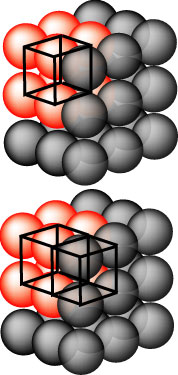
|
It is only necessary here to consider the cubic lattices, of which there are
just the three shown below. They have the obvious names simple, body
centred and face centred, but these derive from the more fundamental
symmetry conditions mentioned above. There are eleven others, of which one of
the most often mentioned is monoclinic, which is the lattice of lowest symmetry.
Once again the lattices below are represented in terms of atoms but are really
lattices of points.
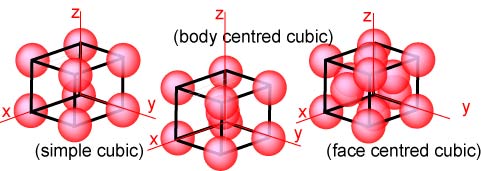
For the determination of structures of solids and for considering the
structural characteristics of surfaces the arrangements of lattice points in
planes of the crystal are important. The different crystal planes are defined by
their Miller indices. The Miller indices of a crystal plane are
constructed by determining the intersection of the plane with the x,y,z axes and
then taking the reciprocals, by convention written as (hkl). In the
examples shown in the diagram below the intercepts of the plane of red atoms are
(1,∞,∞), (∞,1,∞) and (∞,∞,1) on going from left to right. Taking the reciprocals
of each intercept gives the Miller indices (100), (010) and (001) respectively.
Note that each Miller index represents a whole set of planes all parallel to one
another. Thus the expression (100) may be used to indicate either an individual
plane or the whole set of planes.
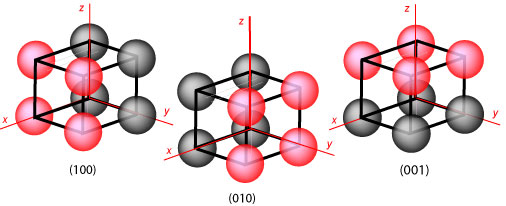
Within the simple cubic cell two other crystal planes are easily identified,
the (110) (there will be a set of planes of this type with different
orientations, of which the (101) and the (011) are the most obvious, but there
are additional ones with negative indices), and the (111). These two and the
(100) are the three sets of planes that are most important for basic surface
studies. The set is shown below with the atoms on the plane and the plane itself
marked in red
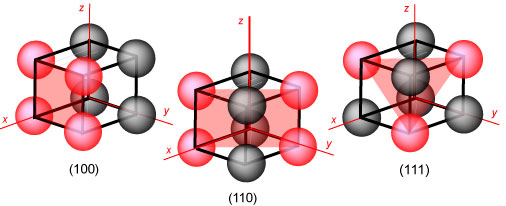
The planes so far shown are low index planes, but there are higher ones. The
way to evaluate the indices of these planes requires a slight alteration in the
procedure. The intercepts of the plane on the xyz axes are all scaled down by
the factor that reduces the highest intercept (other than ∞!) to 1. The diagram
below shows the (210) and (310) planes. In the former the intercepts are the set
(1,2,∞). These are multiplied by 1/2 and the reciprocals then give (210).

For the three cubic structures the structural arrangement within a plane and
between different planes may be different. Below are shown the (100) planes of
simple, body centred and face centred cubic lattices. In the body centred and
face centred cubic structures there are planes of atoms (marked in green)
interleaving the (100) planes. These, together with the (100) planes, make up
the (200) set of planes (intercepts (½,∞,∞).
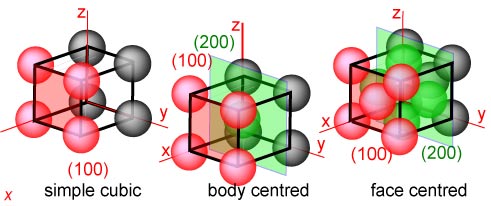
Diffraction from Crystalline Solids
The figure below represents the scattering of radiation from two crystal
planes of a solid. The red and black lines represent radiation reflected from
the upper and lower set of planes respectively. The reflection is treated as
though the two planes of atoms behaved like half-reflecting mirrors. There is a
difference of 2dsinθ in the pathlength travelled by the two beams
of radiation where d is the perpendicular distance between the planes
(the path difference is marked in green and the expanded construction alongside
makes the geometry more clear). As the angle of reflection is changed so does
the difference in pathlength travelled by the two beams. When the path
difference is equal to an integer number of wavelengths the two beams will
reinforce one another and when it is an integral number of half wavelengths the
two waves will interfere destructively with one another. The intensity of the
total reflected radiation will vary sinusoidally with θ. However, if
reflection is from a large set of parallel planes the interference builds up so
that it is destructive at all angles except those satisfying the constructive
interference condition, i.e. when θ is given by
nλ = 2dsinθ
This is Bragg's law. The
method of deriving it here is somewhat unsatisfactory but the alternatives would
require more effort than you need to put in. However, you may find it useful to visit part of my research website where diffraction in one dimension (from a set of slits) and in two dimensions (an array of holes) is discussed in detail with two illustrative applets.
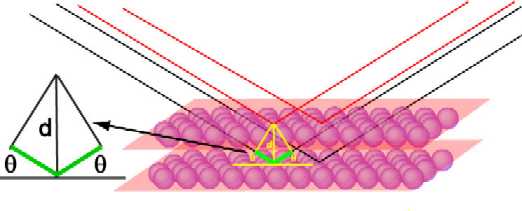
Although the physical model of diffraction given by the Bragg's law approach
is not a good one, the law itself is correct. Thus, the (100) planes of a simple
cubic structure will give diffraction peaks when
sinθ = nλ/2a, n = 1, 2, 3, ..
where a is the lattice parameter. An alternative way of stating this
is to say that there is diffraction from the (100), (200), (300), .. planes at
sinθ = λ/2d, d = a,
a/2, a/3, ..
The two statements are equivalent, but the second
is much more commonly used. Since Bragg's Law applies to all sets of crystal
planes the lattice can be deduced from the diffraction pattern, making use of
general expressions for the spacing of the planes in terms of their Miller
indices. For cubic structures
d(hkl) =
a/(h2 +
k2 +
l2)1/2
Note that the smaller the spacing the higher the angle of diffraction,
i.e. the spacing of peaks in the diffraction pattern is inversely
proportional to the spacing of the planes in the lattice. The diffraction
pattern will reflect the symmetry properties of the lattice. A simple example is
the difference between the series of (n00) reflections for a simple cubic
and a body centred cubic lattice. For the simple cubic lattice, all values of
n will give Bragg peaks. However, for the body centred cubic lattice the
(100) planes are interleaved by an equivalent set at the halfway position. At
the angle where Bragg's Law would give the (100) reflection the interleaved
planes will give a reflection exactly out of phase with that from the primary
planes, which will exactly cancel the signal. There is no signal from
(n00) planes with odd values of n. This kind of argument leads to
rules for identifying the lattice symmetry from "missing" reflections, which are
often quite simple.






